What is Out-of-home (OOH) Advertising?
Out-of-home (OOH) advertising’s presence in the real world has undeniable advantages in today’s digital age. OOH offers a unique blend of broad reach and targeted engagement, untouched by the common challenges of online ad blockers or fleeting screen time.
This article explains what OOH advertising is, providing a list of benefits, ad types and ongoing applicability in the current advertising landscape.
What is out-of-home Advertising?
OOH advertising stands for out-of-home advertising. It refers to any advertising that reaches consumers when they are outside their homes. This form of advertising is designed to capture consumers’ attention on the move, and it’s been a staple in the advertising industry for many years.
Brief history about OOH advertising
Outdoor advertising has ancient roots, with early forms on monuments in civilizations like Ancient Egypt serving as informational guides for travelers.
The evolution of modern advertising began with Johannes Gutenberg’s invention of movable type printing in 1450, leading to the popularity of handbills.
By 1796, illustrated posters emerged, becoming a prominent form of advertisements. Primitive billboards, initially used to guide travelers to hotels, evolved into widespread advertising tools with the evolution of automobiles.
As cars became faster, billboards grew in size for better visibility, leading to regulatory measures like the Highway Beautification Act in the 1960s to prevent landscape obstruction.
The 1990s marked a shift from hand-painted to computer-painted billboards, with the 2000s introducing LED and digital billboards.
Today, technology has revolutionized OOH advertising, introducing interactive elements like smart sensors, facial recognition, and 3D designs, making it more engaging and versatile than ever before.
Why is out-of-home advertising relevant today?
Out-of-home advertising is very effective in building brand awareness–the more consumers see a brand, the more likely they are to recall the brand when making purchase decisions.
Regardless, OOH advertising is extremely effective when it’s combined with other marketing channels (e.g., TV, online ads.) The most successful ad campaigns rely on a multi-channel strategy.
For example, a successful combination of OOH advertising with DOOH advertising can be examined through beaconing, a technology that involves the use of small, wireless devices called beacons to transmit signals to nearby mobile devices or other receivers.
For instance, a grocery store may use beacons to see when a consumer is in the ice cream aisle, and then send them a deal on ice cream cones.
Types of OOH advertising
The U.S. out-of-home advertising market was dominated by billboard ads, accounting for nearly three-quarters (6.2 billion U.S. dollars or 72.7%) of the total spend. The rest was distributed among transit, place-based ads, and street furniture.
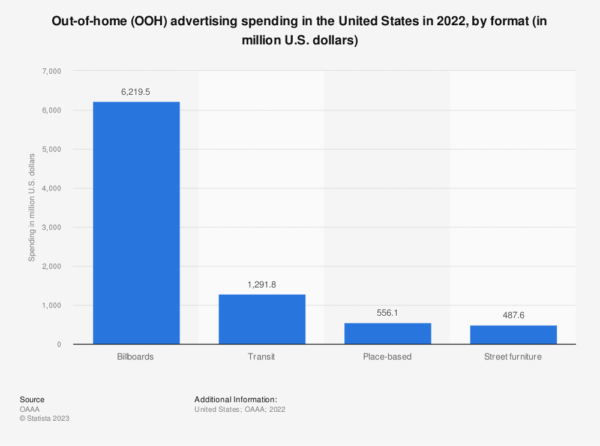
Source: Statista
Here’s an explanation of some of the out-of-home advertising types:
Billboards: titans of the highways
Billboards are large outdoor structures typically found in high-traffic areas such as alongside highways or busy streets. They can be static or digital.
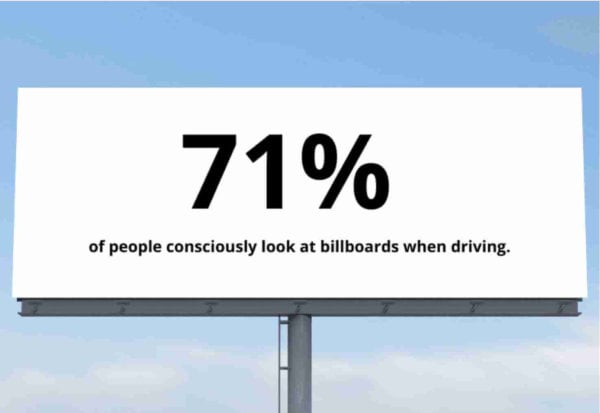
Source: Back40design
Transit advertising: engaging the commuter crowd
Transit advertising includes ads on buses, trains, subways, and taxis. It also encompasses advertising in transit stations.

Source: Contravision
Street furniture advertising: subtly seizing attention
Street furniture includes ads on bus shelters, newsstands, and kiosks.
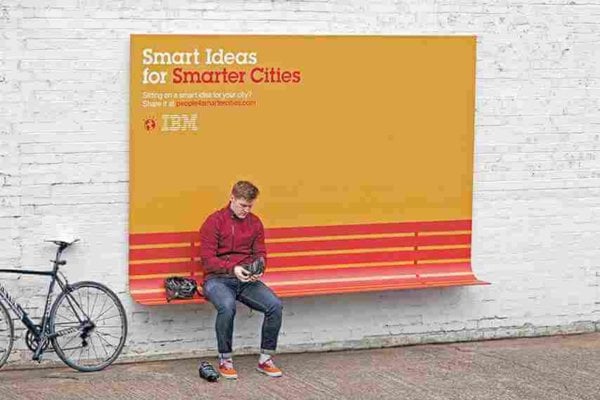
Source: Fubiz
Digital OOH advertising: embracing technology
Digital OOH (DOOH) is a modern evolution of OOH advertising, where digital screens replace traditional static images. It allows for dynamic content changes and interactivity.

Source: Advertisingweek
Key Components of an Effective OOH Advertisement
A 2022 survey highlights two primary attributes of OOH media that brand marketers and agencies highly value:
- The ability to use data for precise audience targeting.
- The vast reach and scale of the medium that ensures visibility to a broad audience.
While OOH advertising’s traditional strength has been its wide reach, the increasing importance of data-driven strategies is evident as marketers and agencies look to combine the best of both worlds: broad visibility with precise targeting.
Here are 9 essential components to focus on for a more effective out-of-home advertising campaign:
1. Design and visual appeal
The design should be eye-catching and memorable. Bold colors, high-quality images, and clear typography can make an OOH ad stand out.
For example, Apple’s billboard campaigns often use minimalistic designs with a clear product image and concise messaging.
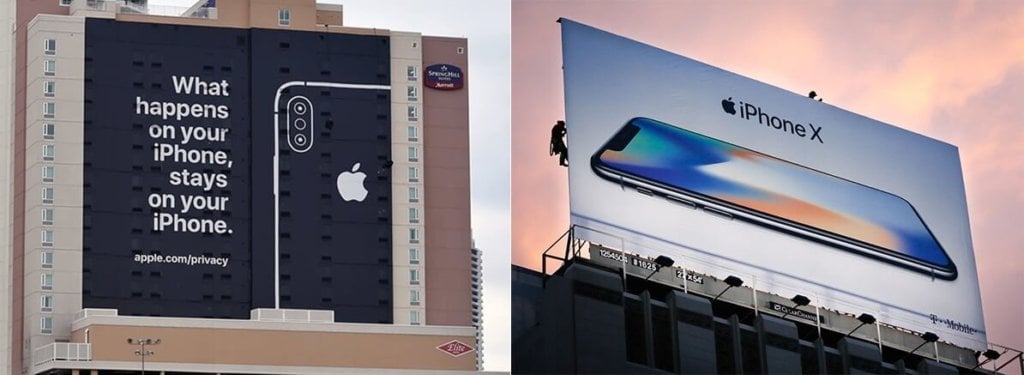
Source: Ken Sengall
2. Location
The placement of the OOH advertisement is crucial. High-traffic areas, such as busy streets, transit hubs, or popular landmarks, can ensure maximum visibility.
For example, a billboard placed near Times Square in New York City would garner significant attention due to the sheer volume of people passing by.
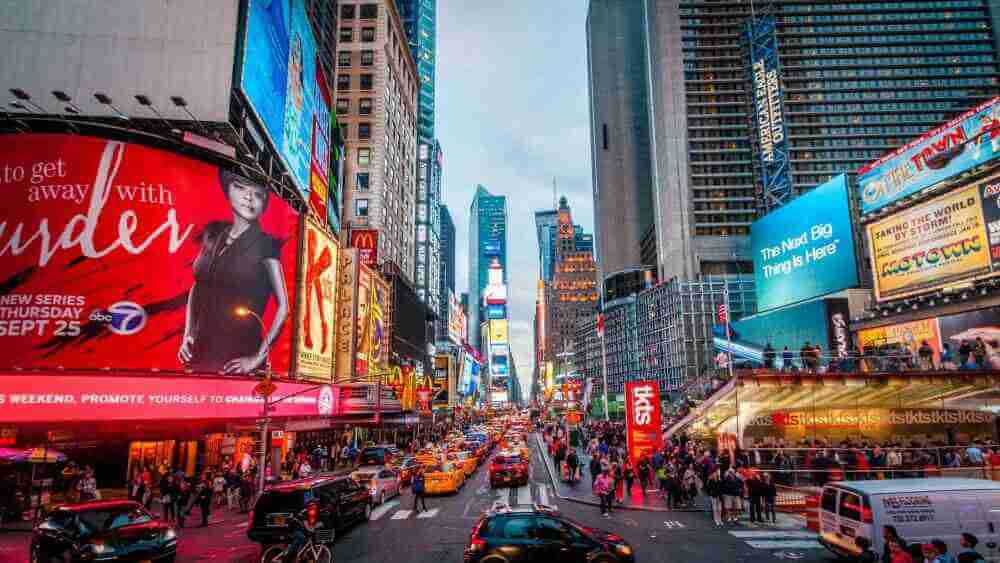
Source: mktoolboxsuite
3. Targeting
Understanding the target audience and placing the ad in locations where they frequently can see it. For example, a billboard for a new fitness center might be more effective near a park where people jog.
4. Message clarity
The message should be concise and clear. Given that passersby often view OOH ads quickly, the message should be easily understood within a few seconds.
McDonald’s often uses this strategy by showcasing their iconic products simply yet effectively.
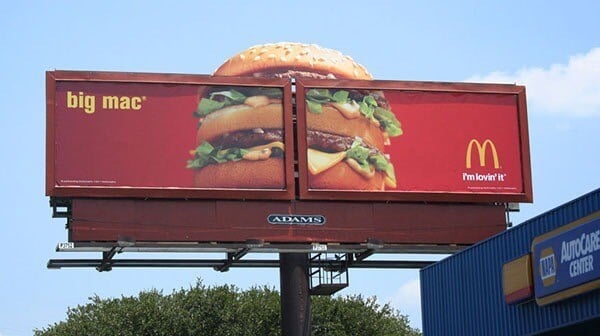
Source: themarketingbirds
5. Creativity
Innovative and unique ads can leave a lasting impression.
For example, IKEA once transformed a bus stop bench into a cozy living room setting, showcasing their furniture in a real-world context.
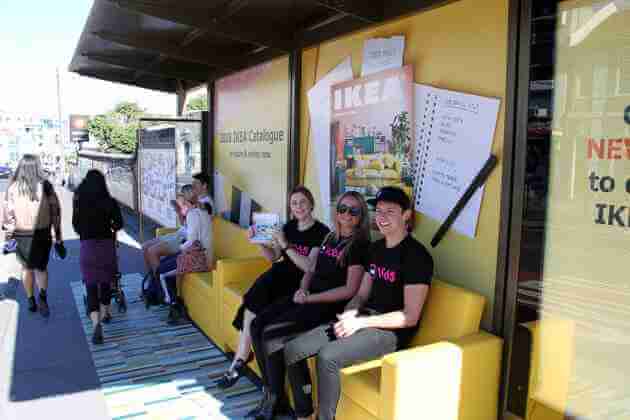
Source: adnews
6. Interactivity
Modern OOH ads can incorporate digital elements, allowing for interactivity. This could be in the form of QR codes, augmented reality, or touch-screen panels.
Pepsi, for instance, created an interactive bus shelter ad in London that gave the illusion of alien invasions, tigers, and other surprising visuals to engage with the public.
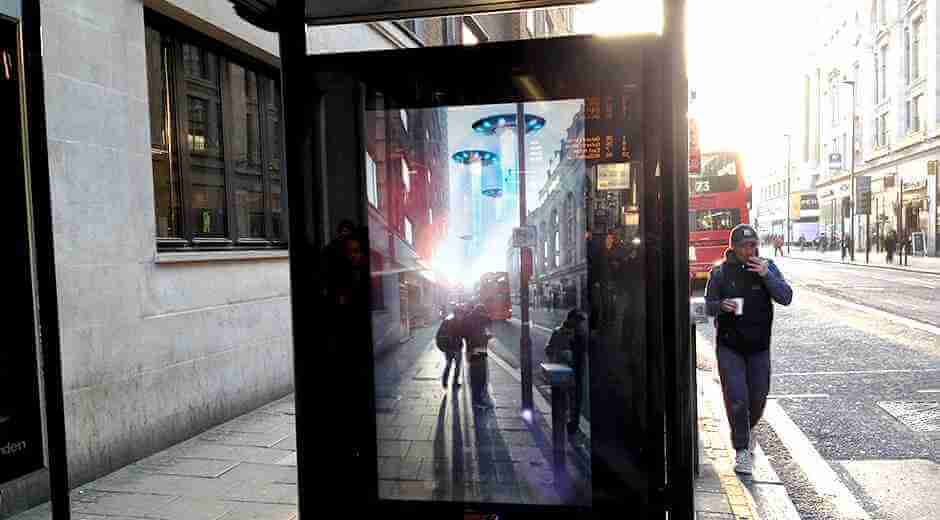
Source: Grand Visual
7. Relevance
The ad should resonate with the current trends, events, or sentiments of the target audience. Seasonal promotions or ads that tap into current events can be more effective.
8. Consistency
If the OOH campaign is part of a larger advertising strategy, maintaining consistency in branding, messaging, and visuals across all platforms can reinforce the brand’s presence.
9. Duration and frequency
The duration in which the ad is displayed and the frequency of its appearance can influence its effectiveness.
A longer display duration can ensure that more people see the ad, while frequent appearances in different locations can reinforce the message.
OOH Advertising and Consumer Behavior
Out-of-home advertising plays a crucial role in influencing consumer behavior and shaping purchasing decisions.
In a 2022 survey, a notable 33% of consumers associated popular brands with the use of outdoor advertising.
Whatsoever, DOOH advertising was found to resonate more with global consumers compared to traditional out-of-home ads. Specifically, 37% of respondents found DOOH advertising entertaining, a figure higher than the 29% for traditional OOH.
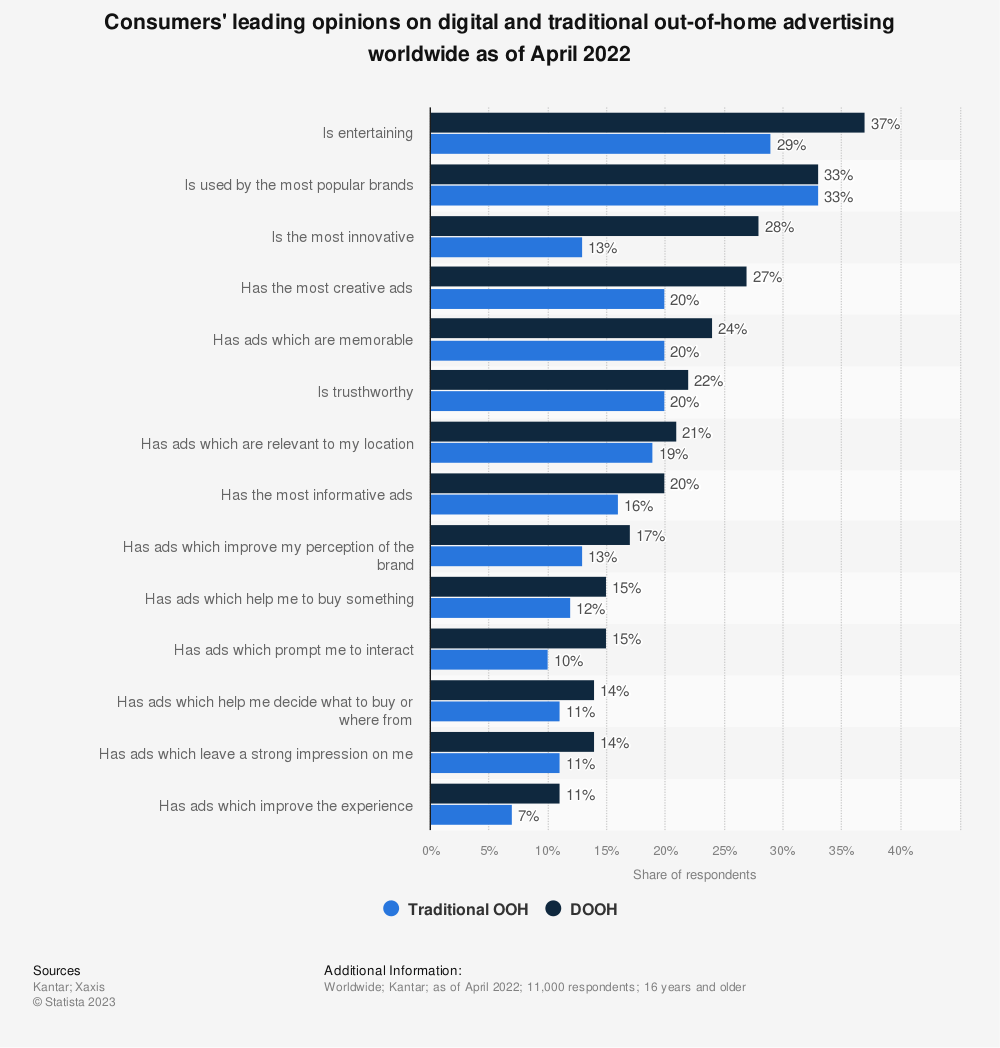
Source: Statista
How OOH Advertising Impacts Purchasing Decisions?
As consumers navigate through urban landscapes, OOH ads, strategically placed in high-traffic areas, serve as constant visual reminders of products, services, or brands.
These visual cues can trigger consumers to make a purchase, especially if the ad resonates with their immediate needs or desires.
OOH Advertising’s Role in Building Brand Awareness?
Beyond immediate sales, OOH advertising is instrumental in building brand awareness. By consistently presenting a brand’s message in various public spaces, OOH ads ensure that the brand remains top-of-mind for consumers.
Over time, this consistent visibility fosters brand recognition and trust, making consumers more likely to choose that brand over competitors when purchasing.
Understanding OOH Advertising Metrics
Here are the 10 most important metrics for OOH advertising:
- Impressions
This is the estimated number of times an advertisement is displayed and potentially seen by individuals. For OOH, this can be calculated based on the location’s foot traffic or vehicle traffic.
- Reach
This metric indicates the total number of unique individuals who have seen the ad over a specific period.
- Frequency
It measures how often an individual sees the advertisement.
In OOH, this can be particularly important in high-traffic areas where the same individuals might pass by the ad multiple times.
- Location data
Given the nature of OOH advertising, the location of the ad plays a crucial role. Metrics related to the location, such as proximity to points of interest or the demographic makeup of the area, can provide insights into the ad’s potential effectiveness.
- Engagement
For digital OOH formats, engagement can be measured by tracking interactions, such as QR code scans or app downloads prompted by the advertisement.
- Recall rate
This measures the percentage of individuals who remember seeing the advertisement after a certain period. It’s an indicator of the ad’s memorability.
- Conversion rate
For OOH campaigns tied to specific actions (like visiting a website or store), the conversion rate measures the percentage of individuals who take that action after seeing the advertisement.
- Return on Investment (ROI)
This metric evaluates the profitability of the advertising campaign. It’s calculated by comparing the revenue generated from the campaign to its costs.
- Dwell time
Especially relevant for digital OOH, this metric measures the amount of time individuals spend in front of the advertisement. A longer dwell time can indicate higher engagement.
- Creative performance
This isn’t a quantitative metric but rather a qualitative assessment of how well the advertisement’s design and message resonate with the audience.
Planning an Effective OOH Advertising Campaign
Here are 6 useful tips on how to plan an effective out-of-home advertising campaign:
1. Having a clear objective
For a successful OOH ad campaign, advertisers should define their target audience, core message, and desired outcome, ensuring that your visuals and content align seamlessly with these objectives for maximum impact.
Setting a budget
Before diving into the specifics of an OOH campaign, it’s crucial to know the advertising budget, i.e., how much one is willing to spend on the campaign.
Distributing funds for ad space rental, design, production, and any additional costs like maintenance or digital features should be taken into consideration.
Key Considerations:
- Formats–what OOH advertising methods will be used? This could be billboards, transit ads, digital screens, etc.
- Location–where will these advertisements be placed? Location can significantly impact the cost and effectiveness of ads.
- Duration–when will the campaign start, and how long will it last?
Identifying target audience
It’s essential to identify the main target audience, and take into consideration consumer demographics, behaviors, and psychographics. Afterward, it’s easier to research where these consumers spend their time outside to ensure that the ads are placed in locations they frequently visit.
Determining location and placement
To maximize the effectiveness of an OOH campaign, it’s essential to research and select locations based on the budget, the geographical area, and intended audience.
Ads placed in high-traffic areas or locations with the right context deliver the maximum impact.
For example, an ad for a coffee shop might be more effective near office complexes or transit stations.
2. Focusing on branding
If a company is new to the market, it might still need to develop a well-defined brand identity.
However, branding is crucial as it differentiates a business from its competitors and encapsulates the essence of its products or services. Before making a big splash with OOH advertising, it’s advisable to solidify the brand identity.
Before launching an OOH campaign, certain branding elements should be firmly established:
- Logos: The visual symbol representing the company. Effective company logo design creates a memorable visual identity for your brand.
- Signature Fonts: Specific typefaces associated with the brand.
- Color Palettes: A set of colors that define the brand’s look and feel.
- Slogans or Mottos: Catchy phrases that encapsulate the brand’s message.
- Product Labels: The design and information on product packaging.
- Tones and Moods: The voice and style used in online content, including social media, websites, and blogs.
- Company Ethos: The core values and beliefs that guide the company.
Once these branding elements are in place, the company is better positioned to create an OOH campaign that grabs attention and fosters a loyal customer base.
OOH ads should be visually striking and easy to comprehend in a short time. It’s essential to use bold visuals, concise messaging, and a clear call-to-action.
Additionally, for digital OOH (DOOH), dynamic content that changes based on time of day, weather, or other real-time factors is recommended.
3. Choosing the right OOH format
Out-of-home advertising offers various formats, including billboards, transit ads (buses, trains, stations), digital screens, posters, and more. Advertisers should select the format that aligns with your objectives, budget, and resonates best with their target audience.
For example:
- Buses–ads on buses can reach a broad audience since they travel from city centers to residential areas. As the bus moves, many people see the ad.
- Bus shelters–these are strategically placed along bus routes. They can capture the attention of both drivers passing by and individuals waiting for the bus.
- Billboards–both static (traditional) and digital billboards offer large spaces for creative displays. They are typically located near busy roads, ensuring high visibility.
Using a combination of different OOH formats can increase the number of times people see the ad (impressions). This multi-format approach can boost the campaign’s effectiveness and motivate potential buyers.
4. Integrating with other marketing channels
Enhancing the effectiveness of OOH campaign can be done by integrating it with digital marketing, social media, radio or TV campaigns. QR codes or unique URLs on OOH ads can be used to track engagement and conversions.
A study in 2021 found that multimedia campaigns yield a higher ROI than campaigns using only one medium. Using multiple platforms prevents diminishing returns and ensures the message has a lasting impact on consumers.
Some of the key takeaways from the study:
- A combination of TV, digital, and OOH advertising resulted in a 27% increase in ROI compared to using them separately.
- Combining TV with OOH ads results in a 21% increase in ROI. OOH complements TV by targeting ads geographically, reaching younger, mobile audiences who watch less TV.
Additionally, OOH advertising enhances ROI in online advertising by 31%, paid-social by 56%, and search by 80%.
5. Monitoring and measuring the campaign performance
Metrics like reach, frequency, impressions, and conversions are used to evaluate the campaign’s effectiveness. Additionally, surveys are used to measure ad recall and brand recognition.
6. Optimizing out-of-home advertising campaign
Just launching an out-of-home ad campaign isn’t the end. Like digital channels, OOH campaigns should be continuously monitored and optimized for maximum effectiveness.
Modern technology enables media planners to track and adjust campaigns in real-time. This dynamic approach ensures that the campaign remains relevant and effective throughout its duration.
Based on performance data, adjustments should be made, like changing ad locations, improving the design, or reallocating budget.
Costs Involved in OOH Advertising
Out-of-home advertising costs vary widely based on the ad type, size, location, and technology. It’s essential to consider these factors when planning your budget for an OOH campaign.
| Cost | |
| Billboards | • Bulletin. Large static ads, costing $750 to $1,500/month in rural areas and up to $30,000/month in cities. Vinyl printing costs an additional $300 to $500. • Poster. Smaller billboards on busy local roads, costing $740 to $2,000/month. • Junior bulletin/poster. Small static ads, prominent in urban areas, costing $300 to $750/month. • Wallscapes/wall murals. Large ads painted on buildings, ranging from $10,000 to $50,000. |
| Street furniture | • Bus shelters. $150 to $6,000/month, depending on the target market. • Benches. $75 to $500/month. • Kiosks. $750 to $15,000, with newsstand kiosks being pricier. • City info pillars. $700 to $2,000, varying by location and type (static or digital). |
| Transit media | • Bus ads. Exterior ads cost $150 to $4,500/month, while interior ads are $20 to $50/month. • Subway ads. $75 to $500/month. • Airport ads. $1,500 to $14,500/month. • Taxi ads. $200 to $1,950/month. |
| Place-based media | • Gas Stations. $150 to $1,800/month for various ad opportunities. • Supermarkets. $800 to $1,500/month for cart ads, welcome panels, and floor graphics. • Restaurants/bars. $300 to $950/month for table tents, posters, and digital ads. • Shopping mall kiosks. $750 to $2,500/month. • College campuses. $500 to $6,500/month. |
| Digital outdoor | • Digital billboards. $1,200 to $15,000/month, depending on location and size. • Spectaculars. Giant screens in popular areas like Times Square can cost over $300,000/month. |
Trends and Future of OOH Advertising
In the dynamic advertising landscape, out-of-home (OOH) advertising is evolving. Current trends highlight the increasing integration of digital technology, with DOOH taking center stage.
These digital displays, often equipped with sensors and connectivity, can adapt in real-time to environmental factors like weather, traffic, or time of day, offering tailored content to viewers.
Additionally, combining OOH with augmented reality and mobile apps enhances interactivity, allowing brands to create immersive experiences that bridge the physical and digital realms.
As for the future, the convergence of data analytics and artificial intelligence promises to revolutionize OOH advertising. This will enable hyper-personalized content delivery, optimizing ad performance based on viewer demographics and behavior.
The Rise of Programmatic DOOH Advertising
What is programmatic advertising – a brief recap:
Programmatic advertising is the automated buying and selling of online ad space using sophisticated algorithms and real-time data analytics, allowing advertisers to target specific audiences and optimize their ad campaigns more efficiently.
Programmatic DOOH isn’t a distinct type of advertising but rather a method of purchasing it. It automates buying, selling, and delivering ads on digital billboards and other digital signages.
Traditional out-of-home advertising is evolving into a digital format known as DOOH. Large companies (e.g., JCDecaux) own digital signages now common in urban areas.
Previously, buying space on these digital billboards was time-consuming and involved many intermediaries. There was also a lack of metrics to measure the success of campaigns, making it difficult for companies to gauge their effectiveness.
How does Programmatic DOOH work?
Advertisers can set specific conditions for their ads using specialized online platforms. When these conditions are met, the ad space is automatically purchased, and the ad is displayed. The conditions can range from specific days and times to footfall data and weather conditions.
The process is very similar to digital advertising, where advertisers bid on ad space in advance. The ad is then displayed when the set conditions are met.
Integration of OOH Advertising with Mobile and Social Media
Out-of-home advertising is a part of the public environment and life. It has a broad audience and reaches consumers at several touchpoints in their daily lives. OOH advertising brings a “one-to-many” ad experience.
Mobile is a constant companion and has evolved into an extension of the consumer. In-app and mobile advertising provides a more personalized experience for users and collects relevant ad engagement and interest data. Mobile advertising brings a “one-to-one” ad experience.
By combining these advertising channels, you can amplify their impact. This can increase brand recognition, loyalty, and engagement, reinforce messaging, and enhance the overall ad campaign efficiency.
The Role of Mobile in Today’s Advertising Landscape
In today’s tech-driven world, mobile apps have become a central point of consumer engagement. This shift towards mobile means that traditional advertising methods, like OOH, must be complemented with effective mobile app marketing strategies. By bridging the gap between physical and digital realms, advertisers can create a cohesive and powerful campaign that reaches consumers at every touchpoint.
Ethical Considerations in OOH Advertising
Out-of-home advertising, just like other forms of advertising, comes with its own set of ethical considerations. OOH advertising regulations vary by country and municipality, but there are some common regulations.
- Media owners can’t freely build or post content anywhere.
Content restrictions ensure that ads are culturally appropriate, truthful, and compliant with advertising standards, including intellectual property rights. Location restrictions protect cultural, historical, or environmentally significant areas, residential zones, and sensitive facilities.
- Ads near competing businesses or sensitive areas like schools are often restricted.
- Size and placement rules dictate the dimensions and positioning of ads to prevent visual clutter and ensure safety.
- Illumination regulations control lighting intensity and timing to avoid distractions.
- Environmental considerations push for sustainable and non-toxic materials.
- Time constraints can dictate ad display duration, and competitive restrictions prevent market saturation.
Additionally, media owners are typically responsible for ad removal, but ads might remain up if not contracted by another advertiser. Understanding and complying with these regulations is crucial to avoid penalties and ensure successful ad campaigns.
Guidelines for Responsible OOH Advertising
While OOH advertising offers unique advantages in terms of reach and visibility, it’s essential to navigate ethical considerations carefully to maintain public trust and ensure the well-being of the community.
For a better understanding, let’s dive deeper into some ethical considerations.
Here are 7 ethical concerns associated with OOH advertising:
- Intrusiveness. OOH ads are placed in public spaces and can’t be easily ignored or turned off like TV or online ads. This presence can be seen as intrusive, especially if the ads are overly aggressive or placed in serene or historically significant locations.
- Cultural sensitivity. OOH ads are visible to a broad audience, including children and people from various cultural backgrounds. Advertisers must be cautious not to display content that might be deemed offensive, inappropriate, or insensitive to certain groups.
- Environmental concerns. The production and disposal of OOH advertising materials, especially large billboards, can have environmental impacts. Sustainable practices, such as using eco-friendly materials and recycling, should be considered.
Additionally, flooding public spaces with ads can lead to visual pollution and detract from the natural or architectural beauty of a place. Balancing commercial interests with aesthetics and public sentiment is essential.
- Safety. OOH ads, especially those with bright lights or moving elements, placed near roads or intersections, can distract drivers and potentially lead to accidents. Ensuring that ads don’t compromise safety is crucial.
- Public welfare. Advertisers should avoid promoting products or behaviors that are harmful to public health or welfare, such as tobacco, excessive alcohol consumption, or illegal activities.
- Consent for placement. Sometimes, OOH advertisements are placed on or near private properties without proper consent, leading to disputes and ethical dilemmas.
- Competitive fairness. Dominating public spaces to the exclusion of competitors, especially in monopolistic ways, can raise ethical questions about fair competition.
Conclusion
Out-of-home advertising still plays a big part in the current advertising landscape. OOH provides a physical touchpoint in an increasingly digital world, linking online and offline interactions.
Its persistent effectiveness is further demonstrated by its capacity to hold viewers’ attention in the real world.
While the advertising landscape continues to shift and evolve, the value proposition of OOH advertising stands firm, offering advertisers a reliable and impactful avenue for brand visibility and engagement.
Frequently Asked Questions (FAQs)
Why is OOH advertising effective in the digital age?
Out-of-home advertising offers consistent visibility in a world of digital ad blockers and saturated online content, capturing attention in real-world settings.
How does digital OOH advertising differ from traditional OOH advertising?
DOOH uses electronic displays to show dynamic, changeable content, while traditional OOH relies on static images or text on physical mediums like billboards.
What industries benefit most from OOH advertising?
The industries of retail, entertainment, travel, and consumer goods often benefit significantly from OOH advertising due to its broad reach and location-specific targeting.
How is the success of an OOH advertising campaign measured?
Success is measured using metrics like increased foot traffic, QR code scans, website visits, or surveys assessing brand recall and awareness.
What are some challenges faced by the OOH advertising industry?
The industry struggles with issues like urban regulations, rapid technological changes, competition with online advertising, and measuring precise ROI.


